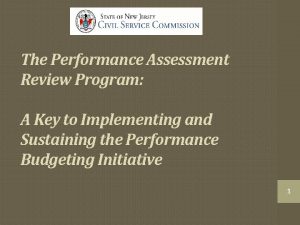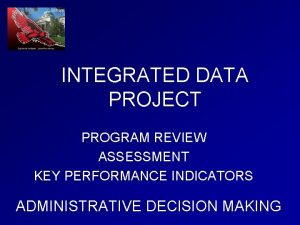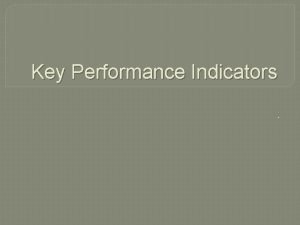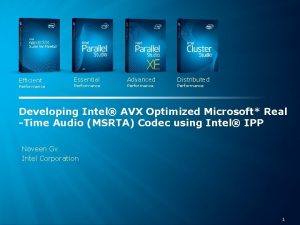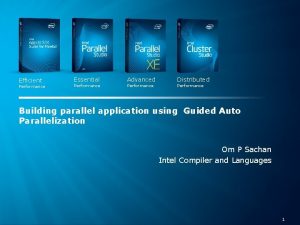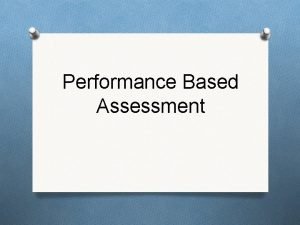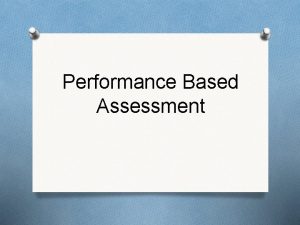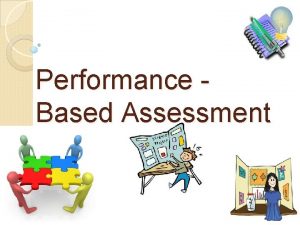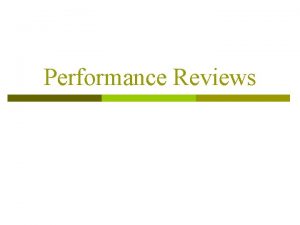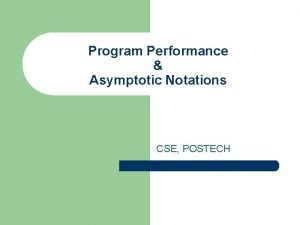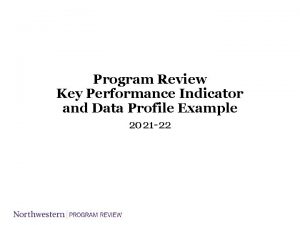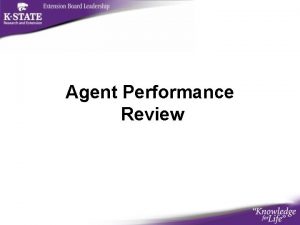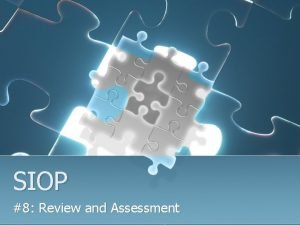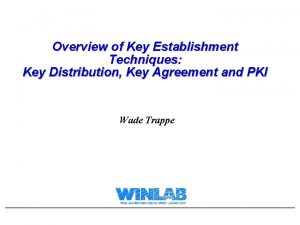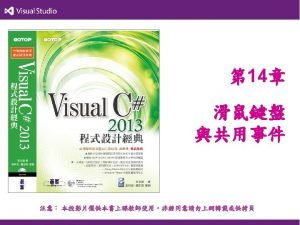The Performance Assessment Review Program A Key to














































- Slides: 46

The Performance Assessment Review Program: A Key to Implementing and Sustaining the Performance Budgeting Initiative 1

Goals of the Civil Service Commission regarding the Performance Assessment Review: • Accountability • Flexibility • Sustainability 2

Accountability • Statute and Regulations regarding performance evaluations for New Jersey State government • PAR Guidance via the LMS (Learning Management System) • e-PAR (Electronic Performance Assessment Review) 3

Civil Service Commission Performance Assessment Review Statutory Basis is N. J. S. A. 11 A: 6 -28, which states: 1. “The commission (Civil Service Commission) shall establish an employee performance system for State employee in the career and senior executive services. The system shall utilize standards and criteria related to job content and program goals…” 2. “The Civil Service Commission shall adopt and enforce rules with respect to the utilization of performance ratings in promotion, layoff or other matters. ” 4

Civil Service Commission Performance Assessment Review • • Regulations are in the New Jersey Administrative Code, N. J. A. C. 4 A: 65. 1, et seq. Who: “a PAR program shall apply to all employees in the career service, and those in unclassified titles as designated by particular departments or agencies. ” How: “The PAR program shall use standardized forms and rating scales for different performance appraisal models to be designated by the Department of Personnel” When: “At the end of six months and at the end of one year, the employee and the supervisor shall review the employee’s performance. The supervisor shall designate an interim performance rating at the end of six months and a final rating at the end of one year. ” Where: http: //www. state. nj. us/csc/employees/programs/performance/ 5

Performance Assessment Review Any Good Performance System Must: Ø Link performance to Core Mission Areas, Goals, and Strategies Ø Tie individual results to program results Ø Measure individual results Ø Enable skill development and job enrichment 6

Performance Assessment Review • Performance Factors • Job Achievement Factors Ø These factors are directly related to the outcomes of the job: Section 1 - Major Goals, Job Responsibility, and Essential Criteria Ø The Organization predetermines Job Achievement Factors 7

8 Performance Assessment Review Major Job Responsibilities Should: Ø Ø Ø Contribute to the Goals and Objectives Be Critical to the job Require a significant amount of Time Include any that are Required by Statute or Regulation Be Done Often Accurately reflect the Actual Work over which employee has control (responsibility, authority and resources to act) 8

Performance Assessment Review Essential Criteria What are they? How many are required? w Essential Criteria are statements w At least one (1) Essential Criteria of conditions that exist when a for every Major Job Responsibility job responsibility has been completed successfully. Try to measure in outcomes, rather than outputs, when applicable. 9

Principles of Essential Criteria Specific Measurable Attainable Reasonable Tied to the Goals of the Organization 10 10

Supervisor’s Tips for Preparing Employee Evaluations Your role as the supervisor should be to shape and develop efficient and effective work performance and behaviors. In an effort to make your meeting with your employees as pleasant and beneficial as possible, consider the following tips: 1. Schedule the meeting well in advance and advise employees of the meeting purpose; indicate what work products and/or required documents should be prepared and brought to the meeting. 2. Review the employee’s departmental file including: � job description and performance expectations; � letters/emails of commendation or complaints; � documentation or notes on previous performance discussions; � samples of work products; � anything else relevant to work behaviors and performance. 3. Determine what questions you will ask to get the information you need to complete the assessment. 4. Focus on the performance and behavior of the worker, not the worker. 5. Identify and establish the job responsibilities and your performance expectations. 6. Identify training needs and/or methods to improve his/her performance and competencies. 7. Identify what motivates your employees considering their future goals and aspirations. 8. Identify how customers, peers and team members view his/her performance. 9. Identify any conduct or performance issues (if applicable indicate date of incident). 10. Identify actions or behaviors employee will need to take to make improvements. 11. Identify what resources or support, if any, will be provided to assist the employee in making the required improvement? 12. Be mindful of the common rating errors: � Leniency Error - Giving everyone high ratings � Central Tendency Error - Clustering all employees in the middle to avoid extremes � Recency Error - Allowing recent events to carry � Contrast Error – Comparing one employee’s performance more influence to another � Halo Effect Error - Allowing favored traits or � Horns Effect Error - Allowing a disfavored trait or work factors to influence all other areas of performance to overwhelm other, more positive performance elements 13. Reflect on your behaviors as a supervisor; have you given adequate time, attention, mentoring, coaching and support 11

e-PAR (Electronic PAR) • CSC has received the required Technical approvals. • CSC conducted a focus group with HR Directors across State Departments and Agencies. • The e-Par system will be part of the My New Jersey portal. • CSC is preparing the design details and requirements. • CSC is working toward a single entry system that would include electronic approvals, and required system reporting. • It is estimated that the e-PAR system will be ready by September 2013 12

Flexibility • Job Banding and the Competency Assessment Review 13

Job Banding Getting the right people, with the right skills, in the right jobs, at the right time 14

Conceptual Basis Core Mission Areas Staffing Plan Strategic Plan Performance Budgeting Key Performance Indicators 15

What Is Job Banding? • Job Banding is a competency based human resource process where similar job titles are grouped together to form career bands. • Advancements are based on a multi-faceted approach including: • An organizational strategic staffing plan • Attainment of competencies • Structured interview 16

Why Job Banding? To make the organizational structure relevant to the core mission Tie individual performance to organization performance indicators To develop a more cohesive and functionally relevant workplace 17

Who Benefits? The Organization by: • Increasing employee productivity and efficiency by boosting competence levels; • Encouraging advancement tied to successful work performance Management by: • Getting expanded scope, increased responsibility, and greater flexibility in deploying and promoting employees • Seeking out and enhancing the skill set of innovative and creative employees by aligning competencies more closely to their jobs Employees by: • Providing the chance to acquire and demonstrate higher-level competencies • Getting the tools to grow through training and career development • Boosting confidence through skill enhancement • Increasing opportunity for mobility 18

Elements of the Job Banding Pilot 1. Pilot Program Proposal 2. Strategic Staffing Plan 3. Competency Assessment Reviews 4. Vacancy and Selection Process 5. Employee Training and Development 19

Step 1: Pilot Program Proposal • Through a pilot project – N. J. A. C. 4 A: 1 • Began in July 2012 • Impacted titles in Civil Service Commission: • Human Resources Consultant Series • Test Development Specialist Series • Personnel and Labor Analyst Series • Impacted titles in OMB: • State Budget Specialist Series *The supervisory level of each title series is not included in the pilot. 20

Step 2: Strategic Staffing Plan • Strategic staffing plan is the “roadmap” for the agency that sets forth a future organizational structure based on: • optimal staffing ratios; • right-sizing the organization; realigning positions, and • reducing costs for current and future needs • Strategic staffing plans differ from traditional staffing activities, which are mainly focused on filling empty seats with new employees 21

Why Use a Staffing Plan? • The plan provides an operational guideline for the organization to make strategic staffing decisions based on fulfilling the core mission and achieving the performance indicators. • It gives managers the structure, tools, and process for defining and addressing the staffing implications of operational planning. 22

Why Use a Staffing Plan? The Plan responds to organizational changes driven by: • reduced funding • expanded services • changes in technology • anticipated reduction of the number of workers • changing needs of customer base. 23

Step 3: Competency Assessment Review (CAR) • What is a Competency? • A competency is a set of defined behaviors that provide a structured guide enabling the identification, evaluation and development of the behaviors in individual employees. • What is the Competency Assessment Review Form (CAR)? • Tool used to evaluate the designated competencies 24

How Competency Model was Developed 1. Specialized workgroup in the Division of Classification & Personnel Management 2. Analyzed job specifications 3. Analyzed PARS and work experience 4. Identified and defined core competencies 25

How Core Competencies Were Defined Based on Dreyfus Model of 5 Levels of Competency Development* Novice Contributing Beginner Competent Proficient Expert *Dreyfus S, Dreyfus H. A five stage model of the mental activities involved in directed skill acquisition. California University Berkeley Operations Research Center; 1980. Available from: http: //www. dtic. mil/dtic/index. html [downloaded 12 January 2009] Journey Person Advanced 26

Dreyfus Novice to Expert Scale Level Knowledge Autonomy Coping with Complexity Novice Minimal or “textbook knowledge Needs close supervision or instruction Little or no conception of dealing with complexity Beginner Working knowledge of key aspects Able to achieve some steps using own judgment, but needs supervision for overall task Appreciates complex situations but only able to achieve partial resolution Competent Good working & background knowledge Able to achieve most tasks using own judgment Copes with complex situations through deliberate analysis & planning Proficient Depth of understanding of discipline and area of practice Able to take full responsibility for own work (and that of others where appropriate) Deals with complex situations holistically, decision-making more confident Expert Authoritative knowledge and deep tacit understanding across area of practice Able to take responsibility for going beyond existing standards Holistic grasp of complex situations, moves between intuitive & analytical approaches with ease 27

Management/Supervisor Role • Communicate & foster job banding concept • Learn and administer new processes • Evaluate competencies • Enhance career development plans 28

Step 4 - Vacancy and Selection Process • Vacancy Announcement • Selection Process • Structured Interview Process 29

Vacancy Announcement An open position is an opportunity to be creative, proactive, and forward thinking in order to create the building blocks for a future organization. Lose One, Fill One We can no longer afford to simply fill a position when it becomes open 30

Vacancy Announcements Things to Consider: How is the position related to the core mission? What are the critical needs of the agency weighed against the budget restraints? What are the benefits of filling the position? What are the consequences of not filling it? What are the work demands of the position? What competencies are needed? How has it changed since it was last vacant? Must the position be backfilled at the same level, different level or at all? 31

32

Factors to Be Considered in the Selection Process Performance Management Elements: • Competency Attainment • Structured Interview • PAR • Not Seniority 33

Step 5: Employee Development • Provide employees with tools to improve Performance • Including but not limited to: • Formal Training • On the Job Training • Special Projects 34

Training and Career Development • Conduct an electronic training needs assessment • Receive and analyze survey results for valued feedback, priorities, and training needs • Develop a training implementation plan • Conduct training courses 35

Training and Career Development Methods of Training: • Classroom Training Partnering With The New Jersey Community College Consortium For Workforce And Economic Development (NJCC Consortium) • E-Learning (Learning Management System) courses on-line 36

Comparison of Performance Management Tools Job Specifications PARS CARS Focus Knowledge, Skills, Abilities Task Achievement Successful Behaviors Purpose What are the Requirements for the job What Tasks should How you should be done perform tasks Used to Evaluate Qualifications Task Performance Behaviors Necessary for Job Scope Broad Narrow Broad & Narrow Frequency of Use for Individual Infrequent – to qualify for a job Semi- Annually Semi Annually until full achievement 37

CSC Competency Assessment Review (CAR) Competency HRC Trainee to 1 Level PLA Trainee to 1 Level TDS Trainee to 1 Level HRC 1 to 2 Level PLA 1 to 2 Level TDS 1 to 2 Level HRC 2 to 3 Level PLA 2 to 3 Level TDS 2 to 3 Level Analytical & Problem Solving Skills x x Communication Skills Customer Relations x x x Leadership Skills Planning & Organizational Skills x x x Self -Management Technical Knowledge x x x x Technology Skills x x Total Number 8 8 9 10 Soft Skills Teamwork 38

Supervisor’s Observations • Specific – use actual examples and relate to definitions described. • Observable – behaviors that you have seen, heard, read, etc. • Actual Performance - tie to actual performance, not length of service • Relate to Achievement of Big Picture- tie employee contribution to performance indicators, unit goals and objectives 39

Sustainability 40 • The N. J. S. T. E. P. Program 40

The N. J. S. T. E. P. Program (Supervisory Training Empowering Performance) is designed to provide supervisors in NJ government with skills that will build and enhance their foundational understanding of the roles, tasks and practices of effective supervision. Through interactive activities and classroom exercises, students will build their competence in applying these concepts in the workplace. 41 The N. J. S. T. E. P. Program 41

The N. J. S. T. E. P. Program was designed with input from our State customers to capture the needs of the target population: supervisors who may be new to the role as well as supervisors who have mastered the transition but have not received formal training in supervisory practices. The program has been developed in partnership with the County College Consortium who will take the lead in delivering the training. 42

N. J. S. T. E. P. is a 7 day (42 hour) program that consists of 12 modules that have been organized around 3 main principles essential to the success of supervisors. 1. Managing Yourself - Leadership; Making the Transition from Co-Worker to Supervisor; Communication-Verbal; Communication-Written; 2. Managing Others - Performance Management; Motivation; Managing Change and Resistance; Addressing Workplace Conflicts; 3. Managing the Work - Planning and Organizing; Team Effectiveness; Problem Solving and Decision Making; and Cultural Competence. 43 The N. J. S. T. E. P. Program 43

The N. J. S. T. E. P. Program Performance Management – Developing an understanding of managing the performance of direct reports through job planning and standards setting, feedback, coaching, performance evaluation and employee development. By the end of this module students will be able to: • Explain the purpose and benefits of performance management to employees • Identify job tasks and set performance standards • Describe seven criteria for meaningful performance feedback • Identify the four requirements and five skills of the masterful coach • Name and explain the actions of each step of the coaching process • Describe how human nature, culture and personal ethos play a role in human response to being evaluated. • Name and define thirteen common supervisory biases and errors in rating employee performance • Identify the evaluation model and form used in the State of NJ • Describe the supervisor’s responsibility and activities in developing employees • Identify the concept of mentoring in the employee development process. 44

“I have ordered the Treasurer to begin using this data to help determine what agencies will be allowed to spend in the future, and which agencies will be cut back for not performing. In this administration, we will pay for performance; not for failure. ” 45 The Buck Stops Here! Governor Christie from www. yourmoney. nj. gov 45

Questions? • Contact: Christopher. Randazzo@csc. state. nj. us 46 Thank You! • N. J. S. T. E. P. : Wayne Jeter, Education Program Development Specialist, Civil Service Commission; Phone: (609) 777 -1558 or Wayne. Jeter@csc. state. nj. us 46
 Chapter review motion part a vocabulary review answer key
Chapter review motion part a vocabulary review answer key Which key activities do partners perform?
Which key activities do partners perform? Contoh bisnis model canvas makanan pdf
Contoh bisnis model canvas makanan pdf Hình ảnh bộ gõ cơ thể búng tay
Hình ảnh bộ gõ cơ thể búng tay Lp html
Lp html Bổ thể
Bổ thể Tỉ lệ cơ thể trẻ em
Tỉ lệ cơ thể trẻ em Gấu đi như thế nào
Gấu đi như thế nào Tư thế worm breton là gì
Tư thế worm breton là gì Alleluia hat len nguoi oi
Alleluia hat len nguoi oi Môn thể thao bắt đầu bằng từ chạy
Môn thể thao bắt đầu bằng từ chạy Thế nào là hệ số cao nhất
Thế nào là hệ số cao nhất Các châu lục và đại dương trên thế giới
Các châu lục và đại dương trên thế giới Công thức tính độ biến thiên đông lượng
Công thức tính độ biến thiên đông lượng Trời xanh đây là của chúng ta thể thơ
Trời xanh đây là của chúng ta thể thơ Mật thư anh em như thể tay chân
Mật thư anh em như thể tay chân Làm thế nào để 102-1=99
Làm thế nào để 102-1=99 Phản ứng thế ankan
Phản ứng thế ankan Các châu lục và đại dương trên thế giới
Các châu lục và đại dương trên thế giới Thơ thất ngôn tứ tuyệt đường luật
Thơ thất ngôn tứ tuyệt đường luật Quá trình desamine hóa có thể tạo ra
Quá trình desamine hóa có thể tạo ra Một số thể thơ truyền thống
Một số thể thơ truyền thống Cái miệng nó xinh thế
Cái miệng nó xinh thế Vẽ hình chiếu vuông góc của vật thể sau
Vẽ hình chiếu vuông góc của vật thể sau Nguyên nhân của sự mỏi cơ sinh 8
Nguyên nhân của sự mỏi cơ sinh 8 đặc điểm cơ thể của người tối cổ
đặc điểm cơ thể của người tối cổ Thế nào là giọng cùng tên?
Thế nào là giọng cùng tên? Vẽ hình chiếu đứng bằng cạnh của vật thể
Vẽ hình chiếu đứng bằng cạnh của vật thể Fecboak
Fecboak Thẻ vin
Thẻ vin đại từ thay thế
đại từ thay thế điện thế nghỉ
điện thế nghỉ Tư thế ngồi viết
Tư thế ngồi viết Diễn thế sinh thái là
Diễn thế sinh thái là Các loại đột biến cấu trúc nhiễm sắc thể
Các loại đột biến cấu trúc nhiễm sắc thể Các số nguyên tố là gì
Các số nguyên tố là gì Tư thế ngồi viết
Tư thế ngồi viết Lời thề hippocrates
Lời thề hippocrates Thiếu nhi thế giới liên hoan
Thiếu nhi thế giới liên hoan ưu thế lai là gì
ưu thế lai là gì Hươu thường đẻ mỗi lứa mấy con
Hươu thường đẻ mỗi lứa mấy con Khi nào hổ mẹ dạy hổ con săn mồi
Khi nào hổ mẹ dạy hổ con săn mồi Hệ hô hấp
Hệ hô hấp Từ ngữ thể hiện lòng nhân hậu
Từ ngữ thể hiện lòng nhân hậu Thế nào là mạng điện lắp đặt kiểu nổi
Thế nào là mạng điện lắp đặt kiểu nổi Performance levels
Performance levels Performance management vs performance appraisal
Performance management vs performance appraisal















































